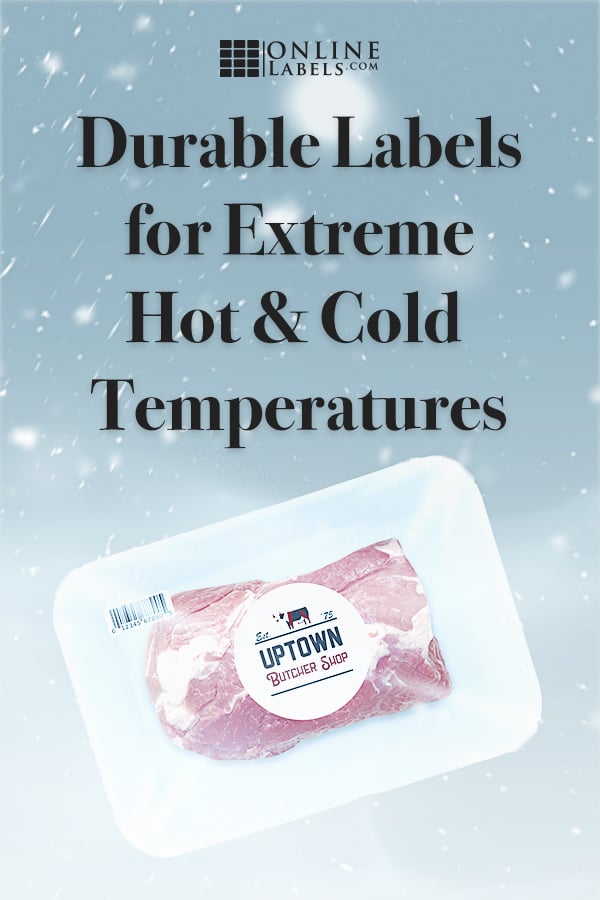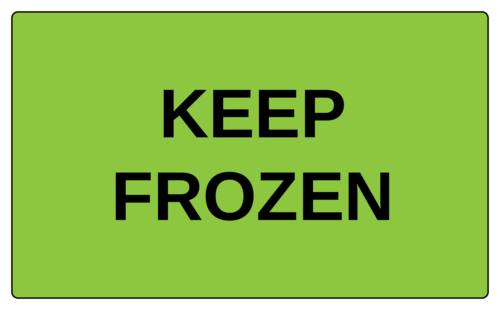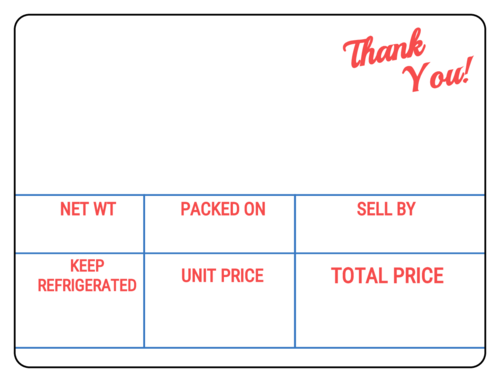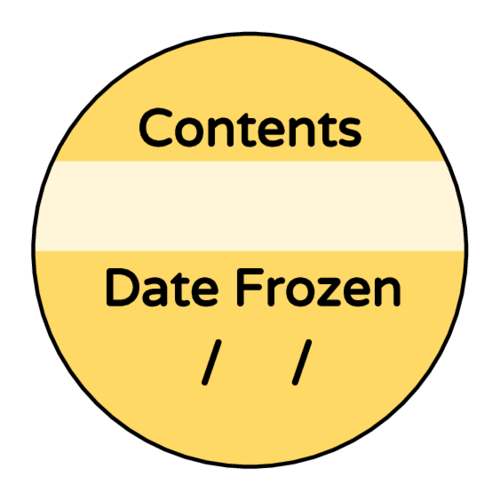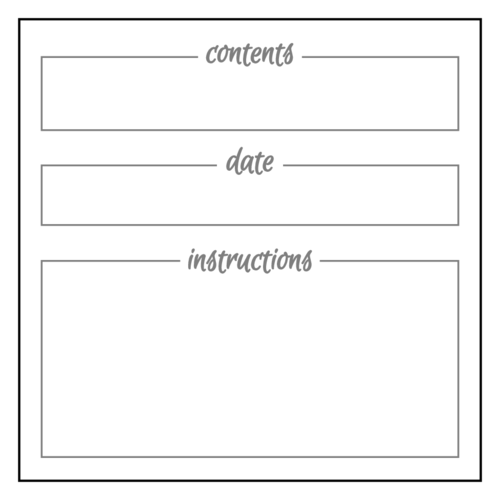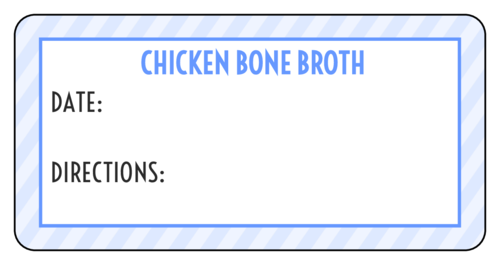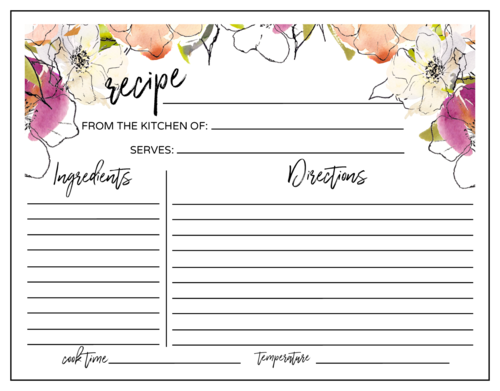Durable Labels for Extreme Hot & Cold Temperatures
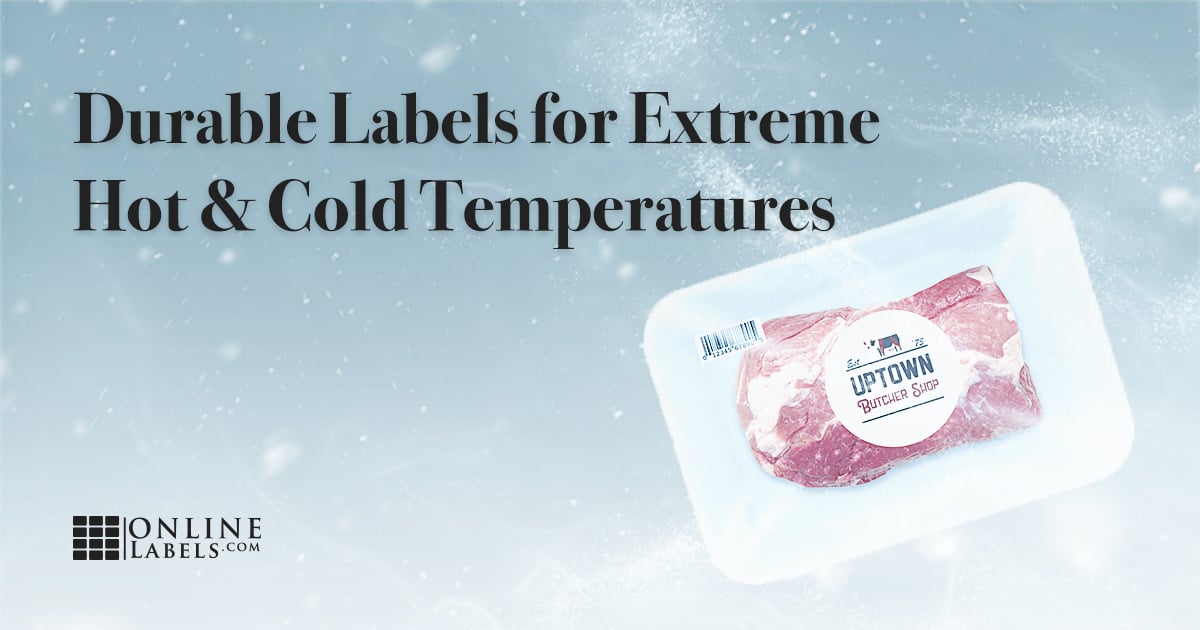
If your products face harsh conditions or climates, OnlineLabels.com offers durable labels that are up for the challenge. Our extreme-heat and freezing cold labels are expert-tested to ensure they keep an attractive and professional appearance no matter your use.
Below, we break down the temperature limits for all of our applicable materials, dive into some common uses for these industrial-grade labels, explore common benefits, and answer frequently asked questions on the topic.
High-Temperature Label Material Specs
| Material | Material Code | Printer Type | Minimum Application Temperature | Service Temperature Range |
|---|---|---|---|---|
| Aggressive White Matte | AT | Laser, Inkjet | -20°F | -65°F to 200°F |
| Weatherproof Gloss Inkjet | WI | Inkjet | 23°F | -20°F to 212°F |
| Weatherproof Matte Inkjet | WJ | Inkjet | 23°F | -20°F to 212°F |
| Weatherproof Polyester Laser | LP | Laser | 25°F | -40°F to 302°F |
| Clear Matte Laser | CX | Laser | 25°F | -75°F to 200°F |
| Clear Gloss Laser | CL | Laser | 25°F | -40°F to 302°F |
| Weatherproof Silver Polyester | SP | Laser | 25°F | -40°F to 302°F |
| Void Silver Polyester Laser | VS | Laser | 25°F | -40°F to 302°F |
| Weatherproof Direct Thermal | DW | Direct Thermal | -8°F | -65°F to 147°F |
| Weatherproof Thermal Transfer | TW | Thermal Transfer | -8°F | -65°F to 147°F |
| Weatherproof White Matte | JW | Inkjet Roll | 23°F | -20°F to 212°F |
| Weatherproof White Gloss | IW | Inkjet Roll | 23°F | -20°F to 212°F |
If your conditions don't require such durable labels, browse our full selection of label materials.
Extreme-Cold Sticker Uses
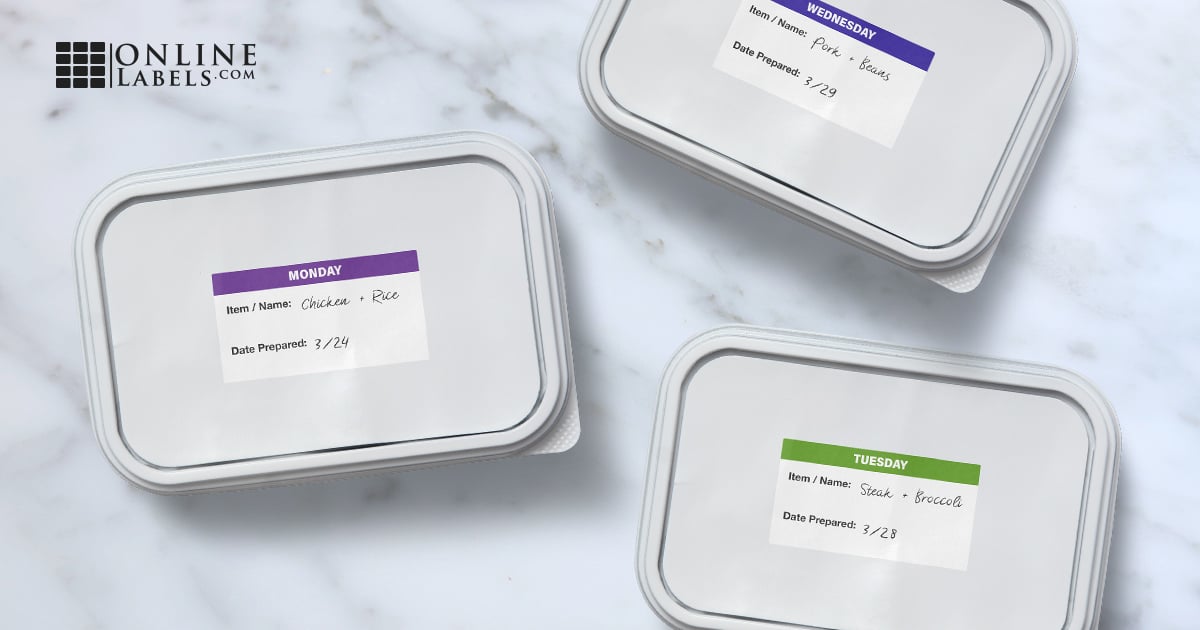
Find compatible low-temperature labels for the cold applications listed below.
- Medical labels – Label lab specimens for testing or frozen/refrigerated storage.
- Freezer labels – Label commercial food products for frozen storage and transport or household meals/containers.
- Safety & warning labels – Protect employees in freezers and cold climates with caution signage.
- Instructional labels – Provide customers with cooking instructions on prepackaged frozen foods or leave organizational instructions for employees in an industrial freezer.
- Barcode labels – Ensure products are scannable at their final destination with freezer-proof barcode labels.
- Snow equipment labels – Keep logo and warning labels on cold-use products like snow shovels, snowblowers, and more.
Pro tip: Laser printing is recommended for applications where slight, incidental contact with moisture is possible. Even incidental contact with moisture could potentially cause inkjet print to smear. In addition, our aggressive white matte material is not considered to be a weatherproof material, so it's not the best choice for any environment where moisture may be introduced.
Extreme-Heat Sticker Uses
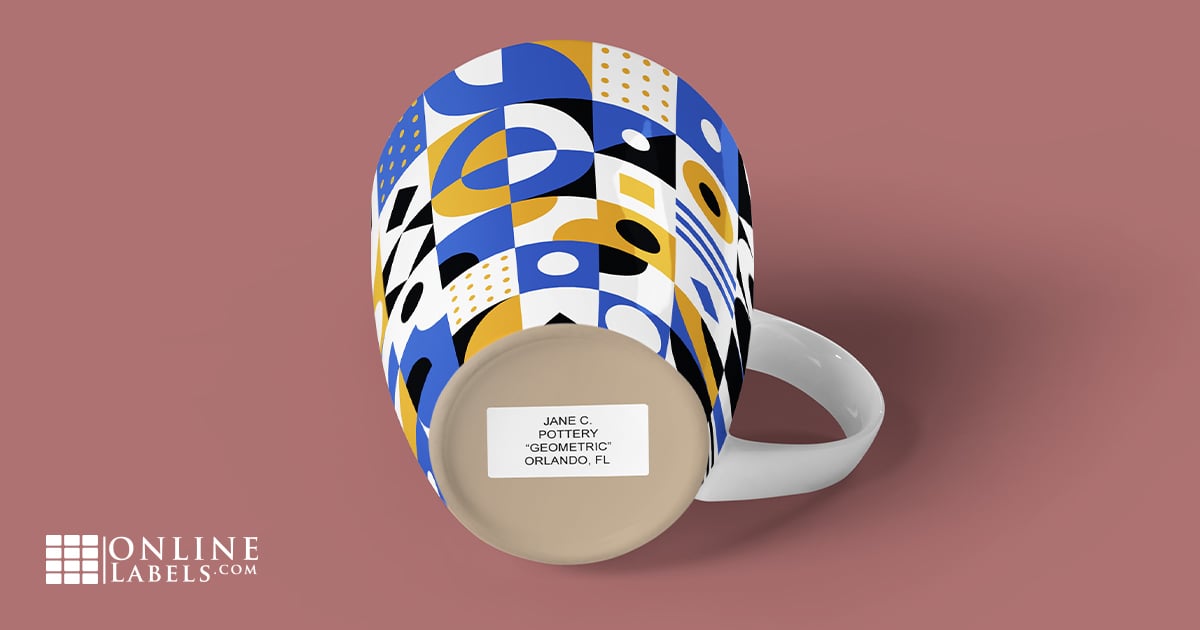
Our labels are compatible with the following hot applications.
- Identification labels – Keep labels intact on tools and products that are used in hot water baths, autoclaves, and more.
- Barcode labels – Ensure products are scannable at their final destination with heat-proof barcode labels.
- Pump and valve labels – Mark water mains, chemical valves, and other pumps to keep communities safe and speed up response in the event of an emergency.
- Soldered and/or galvanized goods – Label necessary soldering and galvenizing tools and nearby products.
- Printed electronic component labels – Barcode and brand electronics with heat-resistant labels.
- Outdoor equipment labels – Keep logo and warning labels on outdoor-use products like lawn mowers, gardening tools, and more.
Temperature-Resistant Label Benefits
Check out the differences between temperature-resistant labels and standard paper-based labels:
- Exceptional durability
- Resistance to abrasion and smudging
- Holds up in direct contact with moisture
- Can withstand short or extended periods at high temperatures
- Doesn't require additional sealants or overcoats
- Can survive multiple cooling or heating cycles
Frequently Asked Questions
With technical applications like frozen good and high-heat labeling, knowing you purchased the right product is important. Here are popular questions and answers to help set you on the right path.
How do freezer/heat-resistant labels work?
The adhesive used on our products is what makes these labels freezer-proof and heat resistant. It's formulated differently to allow for strong performance at different temperature ranges. All of the label materials featured on this page allow for good performance across a wide range of both cold and hot temperatures, but there are some key differences.
The most notable difference is the adhesive used on the weatherproof thermal transfer and weatherproof direct thermal products. These materials have a hot-melt rubber adhesive that is engineered specifically for use at extreme freezing temperatures and on surfaces that may already be damp or wet with moisture.
The rest of the products on this list use an emulsion acrylic adhesive. Those adhesives have a much higher range of temperatures for more effective use with extreme heat applications. However, they're somewhat less effective (but still completely viable) at freezer temperatures.
In terms of the facestock, there are no specialized characteristics aside from paper-based vs. film-based. A polyester or vinyl material will do much better in freezer applications due to the inherent water resistance that the facestock provides. This can be useful for cold/freezer applications where frost or condensation are likely to be present. Learn more about paper vs. film label stock.
How does standard tape compare to cold-resistant labels?
Regular Scotch® tape features an acrylic adhesive and isn't graded for use at extreme temperatures. All of the materials featured on this page will outperform Scotch® tape at both extreme cold and extreme hot temperatures.
Depending on the brand, heavy duty shipping/packaging tape may feature a hot-melt adhesive similar to the adhesive on our weatherproof thermal transfer and weatherproof direct thermal materials. This type of adhesive will perform very well at cold temperatures but isn't ideal for extreme heat applications.
You also get the added benefit of different facestocks with our label materials compared to the main clear packing tape option.
What surfaces do these adhesives adhere to?
All of the materials listed on this page feature adhesives that are graded for use on a wide variety of surfaces like plastic, glass, foil, and metal.
Due to the nature of hot-melt rubber adhesive, the weatherproof thermal transfer and weatherproof direct thermal materials are the best choices for heavily textured and rough surfaces, as well as surfaces that are already damp or moist. The only limitation with these two products is that plasticized or soft PVC should be avoided. Hard PVC (like the PVC popular for pipes, plumbing, packaging, etc.) is fine.
The other materials should do fine on textured surfaces if thermal roll printing isn't an option. Get more information on switching to roll labels.
If you're dealing with an unusual or difficult surface, request a label sample. We want to ensure the labels you choose are right for your application.
How do you label a container for the freezer?
Our temperature-rated labels are compatible with most popular printers or you can choose to use them with standard writing utensils.
What writing utensils are best for use in dramatically low and high temperatures?
The majority of these materials feature film-based facestocks, so you'll want to use a permanent marker to ensure any written information holds up.
The aggressive white matte is an uncoated paper-based material so you have some additional flexibility with this product. A permanent marker is still the best option for harsh environments, but regular ink pens will work fine on this material as well. See what other writing utensils we tested on this material.
Will these labels stick to items that are already frozen?
All of these materials have an application temperature below 32°F so they're all technically capable of being applied to frozen surfaces.
The weatherproof thermal transfer and weatherproof direct thermal materials are the best options for application to an already frozen surface. The hot-melt rubber adhesive is designed for applications at extremely low temperatures (-8°F) and handles well on moist surfaces.
The aggressive white matte is also an excellent choice, but it will perform best in frozen applications when used with a laser printer. Inkjet prints could smear as frozen products begin to defrost and condensation is introduced.
The weatherproof gloss inkjet and weatherproof matte inkjet materials are still viable for basic frozen applications, but may not perform as well in these conditions as the other items.
Will the print fade or bleed during use?
As long as the proper printer settings are used, the print should not fade or bleed during use at extreme temperatures.
For laser materials, use photo, glossy, or labels as the material setting in your printer dialog box. For inkjet materials, select photo or glossy as the material settings.
Are there templates available?
We have complimentary blank and pre-designed label templates for all of our label shapes, sizes, and configurations. Our most popular freezer label pre-designed templates are shown below.
If you have questions about any of the label materials listed above, please contact our customer service team directly. We're happy to help you find a label that will work for your unique product or application. Call us at 1-888-575-2235.
While these materials are our most durable products, the surface that they're applied to will ultimately have a major impact on their overall performance. To ensure our temperature rated labels will meet your needs, test a small quantity of labels with your specific application before purchasing and applying the labels en masse.
